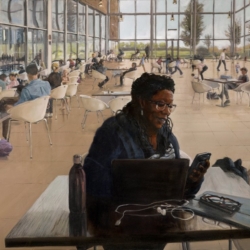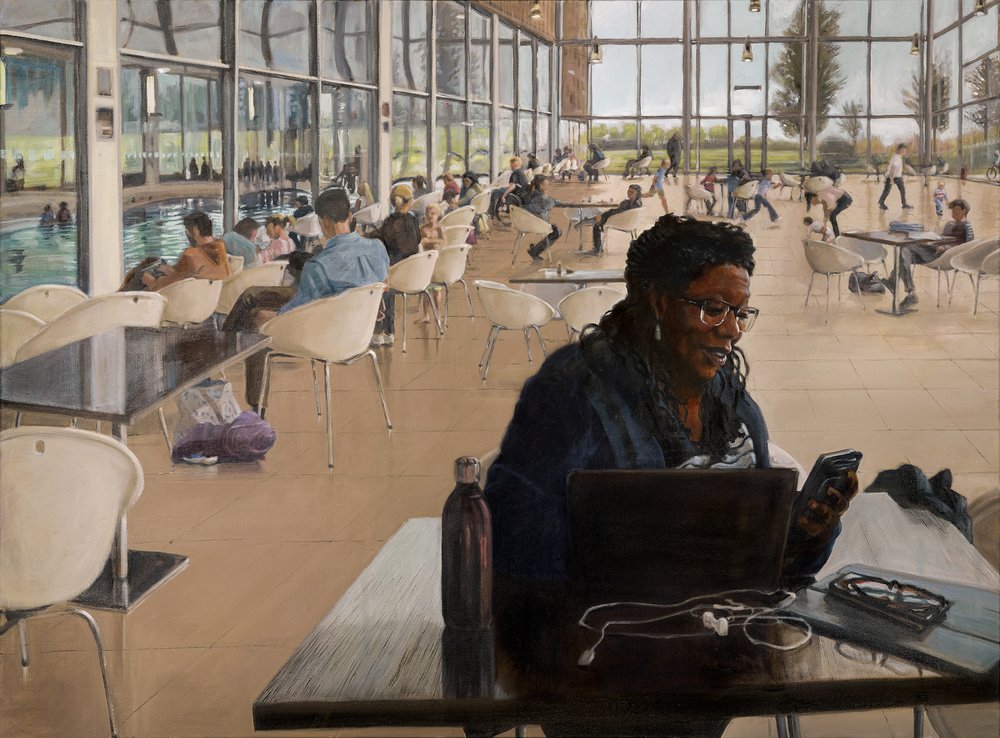 Walking into Bristol-based artist Gail Reid’s studio, I literally stopped in my tracks! There it was a painting of everything I had been researching and writing about with workplace strategist Chris Kane for our book “Where Is My Office?” both pre-and post-pandemic. Gail, was a Semi-Finalist in this year’s Sky Art’s Portrait Artist Of The Year – alas she didn’t make the final – although she impressed everyone with her talent and charisma. She also impressed me in managing to convey via the very traditional medium of an oil painting, a quintessential 21st century phenomenon – working from anywhere.
Walking into Bristol-based artist Gail Reid’s studio, I literally stopped in my tracks! There it was a painting of everything I had been researching and writing about with workplace strategist Chris Kane for our book “Where Is My Office?” both pre-and post-pandemic. Gail, was a Semi-Finalist in this year’s Sky Art’s Portrait Artist Of The Year – alas she didn’t make the final – although she impressed everyone with her talent and charisma. She also impressed me in managing to convey via the very traditional medium of an oil painting, a quintessential 21st century phenomenon – working from anywhere.
What Gail has cleverly captured is how the availability of efficient, high-speed internet and mobile-data connectivity, effective cloud-based services and improved cyber-security has enabled all of us to work anytime, anywhere and anyplace. How many of us have found ourselves in similar circumstances to Angela, the central figure in the painting, juggling various bits of technology as we ‘plug and play’ into our work on the go?
ehind Angela, all our normal everyday lives are played out: children swimming, toddlers running around, friends or colleagues meeting up for coffee, a teacher marking papers (WFA again) – the ultimate real-life example of the humancentric workplace. It goes to the crux of the current debate – does it matter where and what time we do the work, if it is completed and achieved to the standard required? Does the location matter that much, if we are producing the right outcome?
In fact at the time of the painting Angela was growing her business Better Together (an on-line safety enterprise for parents/carers and other professionals). Entrepreneur Angela and Gail the artist would regularly co-work at the leisure centre while their children took after-school sports lessons. Both busy working mothers proving how decoupling from a fixed desk and the Monday-to-Friday, 9-5 routine, plus ditching that time-consuming commute every day can be a huge bonus to parents and carers.
The ability to fit work around your children’s or family life, especially since child and/or caring for sick or elderly relatives is so costly and not easily available, has meant that since February 2023, the labour force participation rate for women between the ages of 25 and 54 has exceeded an all-time high (at least in the USA). It has grown exponentially from 51 per cent in 2017 to 77 per cent in 2023 and the rise of flexible working especially for knowledge workers has certainly contributed to this number. (Research from the Hamilton Project at the Brookings Institution, August 2023)
Even before the global lockdowns flexibility was already a feature in the workplace: 20 years ago, people were putting flexibility and personal development above salary. In 2019, the US Bureau of Labor Statistics indicated that 57 per cent of American employees had some form of flexible working arrangements. Additionally, the 2019 IWG Annual Global Study demonstrated that 85 per cent of over 15,000 businesses worldwide confirmed that greater workplace flexibility led to an increase in productivity and a happier workforce.

Furthermore, the penny had also started to drop within management teams even pre-pandemic that an effective and efficient workplace contributes to the attraction and retention of its talent. After all, people are a business’s most valuable resource and, ultimately, their engagement with their working environment is paramount to an organization’s success. The important question here is: how many business leaders have made the connection between productive staff and a productive workplace? And more importantly, for many management leaders the workplace still means an office and not home, Starbucks or a leisure centre.
As we can see there seem to be many shades of ‘hybrid’ working; from mandating set days of the week which must be worked at a specific location, while others are going beyond the binary home/office model. This includes giving their workers more distributed options such as access to ‘third space’ work hubs or co-working spaces nearer their homes.
The trick that most people are still missing is that we have all been working in a flexible ‘hybrid’ way for at least a decade and several years before the pandemic lockdowns accelerated the pace of changing the way we work. Some workplace practitioners hate the word hybrid; understandably, since it limits working to a ‘home versus office’ binary option, others prefer to use the term ‘seamless’.
Seamless working acknowledges the fact that people work in tandem with going about their daily lives – taking calls, having Zoom meetings, writing emails, viewing reports, setting up businesses etc. on their lunch breaks, walking in the park, on the school run, on a beach, in a leisure centre. However, they are still working and producing regardless of where they are. So unwittingly we were already living and doing hybrid ways of working and what Gail has portrayed so accurately is in fact the true reality of the 21st century Industrial Revolution….in a leisure centre!
Image: Industry by Gail Reid. Semi-Finalist, Sky Art’s Portrait Artist Of The Year 2023 https://www.gailreidartist.com/about
Angela Loveridge. Better Together Online Safety Company. https://btogether.org.uk/
Eugenia Anastassiou is an editor and writer at EverythingOmni and the co-author with Chris Kane of Where Is My Office? The Post Pandemic Edition published by Bloomsbury.














March 9, 2024
Industry: the art of working from anywhere
by Eugenia Anastassiou • Comment, Everything Omni, Flexible working
What Gail has cleverly captured is how the availability of efficient, high-speed internet and mobile-data connectivity, effective cloud-based services and improved cyber-security has enabled all of us to work anytime, anywhere and anyplace. How many of us have found ourselves in similar circumstances to Angela, the central figure in the painting, juggling various bits of technology as we ‘plug and play’ into our work on the go?
ehind Angela, all our normal everyday lives are played out: children swimming, toddlers running around, friends or colleagues meeting up for coffee, a teacher marking papers (WFA again) – the ultimate real-life example of the humancentric workplace. It goes to the crux of the current debate – does it matter where and what time we do the work, if it is completed and achieved to the standard required? Does the location matter that much, if we are producing the right outcome?
In fact at the time of the painting Angela was growing her business Better Together (an on-line safety enterprise for parents/carers and other professionals). Entrepreneur Angela and Gail the artist would regularly co-work at the leisure centre while their children took after-school sports lessons. Both busy working mothers proving how decoupling from a fixed desk and the Monday-to-Friday, 9-5 routine, plus ditching that time-consuming commute every day can be a huge bonus to parents and carers.
The ability to fit work around your children’s or family life, especially since child and/or caring for sick or elderly relatives is so costly and not easily available, has meant that since February 2023, the labour force participation rate for women between the ages of 25 and 54 has exceeded an all-time high (at least in the USA). It has grown exponentially from 51 per cent in 2017 to 77 per cent in 2023 and the rise of flexible working especially for knowledge workers has certainly contributed to this number. (Research from the Hamilton Project at the Brookings Institution, August 2023)
Even before the global lockdowns flexibility was already a feature in the workplace: 20 years ago, people were putting flexibility and personal development above salary. In 2019, the US Bureau of Labor Statistics indicated that 57 per cent of American employees had some form of flexible working arrangements. Additionally, the 2019 IWG Annual Global Study demonstrated that 85 per cent of over 15,000 businesses worldwide confirmed that greater workplace flexibility led to an increase in productivity and a happier workforce.
Furthermore, the penny had also started to drop within management teams even pre-pandemic that an effective and efficient workplace contributes to the attraction and retention of its talent. After all, people are a business’s most valuable resource and, ultimately, their engagement with their working environment is paramount to an organization’s success. The important question here is: how many business leaders have made the connection between productive staff and a productive workplace? And more importantly, for many management leaders the workplace still means an office and not home, Starbucks or a leisure centre.
As we can see there seem to be many shades of ‘hybrid’ working; from mandating set days of the week which must be worked at a specific location, while others are going beyond the binary home/office model. This includes giving their workers more distributed options such as access to ‘third space’ work hubs or co-working spaces nearer their homes.
The trick that most people are still missing is that we have all been working in a flexible ‘hybrid’ way for at least a decade and several years before the pandemic lockdowns accelerated the pace of changing the way we work. Some workplace practitioners hate the word hybrid; understandably, since it limits working to a ‘home versus office’ binary option, others prefer to use the term ‘seamless’.
Seamless working acknowledges the fact that people work in tandem with going about their daily lives – taking calls, having Zoom meetings, writing emails, viewing reports, setting up businesses etc. on their lunch breaks, walking in the park, on the school run, on a beach, in a leisure centre. However, they are still working and producing regardless of where they are. So unwittingly we were already living and doing hybrid ways of working and what Gail has portrayed so accurately is in fact the true reality of the 21st century Industrial Revolution….in a leisure centre!
Image: Industry by Gail Reid. Semi-Finalist, Sky Art’s Portrait Artist Of The Year 2023 https://www.gailreidartist.com/about
Angela Loveridge. Better Together Online Safety Company. https://btogether.org.uk/
Eugenia Anastassiou is an editor and writer at EverythingOmni and the co-author with Chris Kane of Where Is My Office? The Post Pandemic Edition published by Bloomsbury.